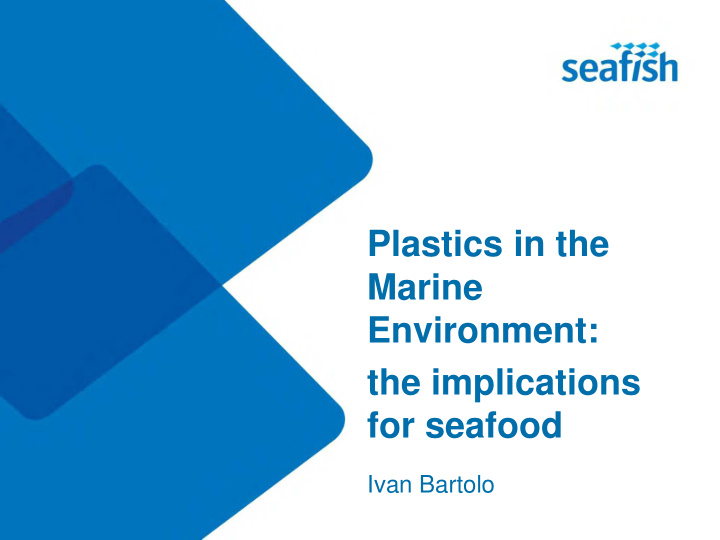



Plastics in the Marine Environment: the implications for seafood Ivan Bartolo
Plastics and microplastics Plastic production has risen steadily since the mid-1950s Plastics degrade in the marine environment forming micro and nanoplastics Public awareness has increased significantly 2
Plastics and microplastics Much of the plastic we use ends up in the sea clothes tyres microbeads Larger items degrade in the sea: bags bottles fishing nets 3
Plastics Polymer type Examples of uses Low density polyethylene (LDPE) Plastic carrier bags, general packaging, squeeze bottles, netting, drinking straws Kitchenware, jerry cans, toys, fishing High density polyethylene (HDPE) nets, microbeads Carpets, twine, clothing, structural foam, Polypropylene (PP) automotive parts Polystyrene (PS) Vending cups, food containers Polyamide (nylon) (PA) Textiles, fishing line, netting, car parts Polyester (PES) Textiles, films Acrylic (AC) Textiles, paints Polyoxymethylene (POM) Car parts, housing parts, food conveyors Polyvinyl alcohol (PVA) Papermaking, textiles, coatings Polyvinyl chloride (PVC) Packaging, cling film, cable insulation Poly methylacrylate (PMA) Safety glass, coatings Polyethylene terephthalate (PET) Food packaging, bottles 4
Microplastics and nanoplastics Microplastics: < 5 mm Nanoplastics: <100 nm C. C. 50µm A, B, Hermsen et al. 2017; C, Shreya Sonar (Patagonia, 2017) 5
Microplastics: our concerns The marine ecosystem and the sea as a source of food Microplastics in seafood Our overall exposure 6
Microplastics: our concerns Direct effects Indirect effects Nano effects Physical Chemical Microbiological 7
Microplastic effects Direct effects Sub-lethal effects on plankton Found in the stomachs of fish, seabirds, marine mammals Evidence they may cross into organs if <150µm Cole et al. 2013; A, B: Hermsen et al. 2017 8
Microplastic effects Indirect chemical effects Present from manufacturing process Adsorption from marine environment, due to hydrophobic nature Concentration (up to x10 6 ) PAHs, PCBs, OC pesticides, polybrominated compounds, endocrine disruptors, metals EFSA: Exposure is minor compared to ordinary exposure to BPA and PCBs including dioxins 9
Microplastic effects Microbiological effects Microorganisms including human pathogens can colonise microplastics Gene exchange between microbes associated with microplastics Vectors for adsorbed antibiotics Vector for the fish pathogen Aeromonas salmonicida 10
Nanoplastic effects Nanoplastics can enter cells. Some engineered nanomaterials have shown toxic effects (inflammation, liver and kidney effects, secondary genotoxic effects). Introducing nanoplastics into molluscs, sea urchins, chickens and human cell lines demonstrated a variety of harmful effects. Toxicity effects on humans are unknown. Analytical methods need to be developed. Occurrence data in food is absent. 11
Plastics and seafood Marine organisms are exposed to microplastics and ingest them Microplastics can enter the human food chain via the food we eat Much of the research on microplastics in seafood has focused on shellfish 12
Exposure to microplastics Top mussel consumers (older Belgian citizens): 11,000 particles/person/year Average UK consumer: 125 particles/person/yr Household dust ingested during meals: 14,000 – 68,000 particles/person/year Potential reputational risk for the industry 13
Characterising the risk Risk matrix Information matrix To map our level of understanding of the various microplastic risks What information is currently available? How robust? Known hazards Mitigation measures Information gaps Ongoing research 14
Risk / information matrix Physical hazard of plastic microparticles Current MP/NP are ubiquitous in the aquatic / marine environment. information Variable sizes, densities and shapes. Known issues, Transfer to marine organisms in all trophic levels, including hazards, risks seafood species. Size and shape effects. Presence of MP in the gut of several species confirmed. Presence of MP & NP in organs following transport across the gut. Lab trials confirm they are physical stressors with effects on health. Mitigation Removal of plastics; marine clean-up schemes; onshore and measures marine waste management; depuration of molluscs and crustaceans Information & How widespread the MP/NP are; no standard testing methods knowledge gaps for identification, enumeration and characterisation; no way to remove NPs from marine environment Current research Efforts to standardise testing methods 15
Risk / information matrix The micro/ Physical nanoparticles Chemical Microbiological The marine Physical environment; Environmental impacts on marine life Sources of Seafood: molluscs / crustaceans / finfish ingestion by Food & drink: water / beer / honey / salt / other proteins humans Other sources: inhaled air / house dust deposition / packaging / textiles Consumer Awareness perception Perception Regulation Food Environmental 16
Characterising the risk We can only partially characterise the risk associated with microplastics. Seafish will assess current knowledge and ongoing research. Seafish aim to publish guidance on how businesses can mitigate risk 17
Thank you Ivan.Bartolo@seafish.co.uk
Recommend
More recommend